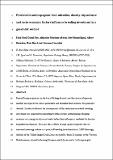Por favor, use este identificador para citar o enlazar a este item:
http://hdl.handle.net/10261/156470COMPARTIR / EXPORTAR:
 SHARE SHARE
 CORE
BASE CORE
BASE
|
|
| Visualizar otros formatos: MARC | Dublin Core | RDF | ORE | MODS | METS | DIDL | DATACITE | |

| Título: | Predictable anthropogenic food subsidies, density-dependence and socio-economic factors influence breeding investment in a generalist seabird |
Autor: | Real Garcia, Enric CSIC ORCID CVN; Oro, Daniel CSIC ORCID CVN ; Martínez-Abraín, Alejandro CSIC ORCID; Igual, José Manuel CSIC ORCID ; Bertolero, Albert; Bosch, M.; Tavecchia, Giacomo CSIC ORCID | Fecha de publicación: | ene-2017 | Editor: | John Wiley & Sons | Citación: | Journal of Avian Biology 48(11): 1462-1470 (2017) | Resumen: | Recent European policies on the ban of fishing discards and the closure of open-air landfills are expected to reduce predictable and abundant food resources for generalist seabirds. In order to forecast the consequences of this reduction on seabird breeding investment it is important to understand whether diverse anthropogenic foraging resources act synergistically or not and whether their influence is mediated by density-dependent mechanisms. To assess these effects at large spatio-temporal scale, we measured mean egg volume as a proxy of breeding investment in ca. 5,000 three-egg clutches of the Yellow-legged Gull (Larus michahellis) from 20 colonies of the Western Mediterranean, located both along European and African coasts. In European gull colonies, egg volume increased with the availability of fishing discards and landfills in the vicinity of the colony. However, the landfill effect was weaker than the effect of fishing discards, probably due to the lower quality of waste as food for gulls. In contrast, none of the anthropogenic food subsidies influenced egg volume in African colonies, likely due to socio-economic differences (i.e. a much lower availability and predictability of both discards and waste food. Finally, results showed that the positive association between fishing discards and open-air landfills on egg volume was mediated by negative density-dependent mechanisms probably related to an increase in competition for food. | Versión del editor: | https://www.doi.org/10.1111/jav.01454 | URI: | http://hdl.handle.net/10261/156470 | DOI: | 10.1111/jav.01454 | ISSN: | 0908-8857 | E-ISSN: | 1600-048X |
| Aparece en las colecciones: | (IMEDEA) Artículos |
Ficheros en este ítem:
| Fichero | Descripción | Tamaño | Formato | |
|---|---|---|---|---|
| Real_et_al_2017_Predictable_anthropogenic_food_subsidies.pdf | 1,66 MB | Adobe PDF |  Visualizar/Abrir |
CORE Recommender
SCOPUSTM
Citations
34
checked on 10-abr-2024
WEB OF SCIENCETM
Citations
36
checked on 24-feb-2024
Page view(s)
329
checked on 19-abr-2024
Download(s)
3.918
checked on 19-abr-2024
Google ScholarTM
Check
Altmetric
Altmetric
NOTA: Los ítems de Digital.CSIC están protegidos por copyright, con todos los derechos reservados, a menos que se indique lo contrario.
